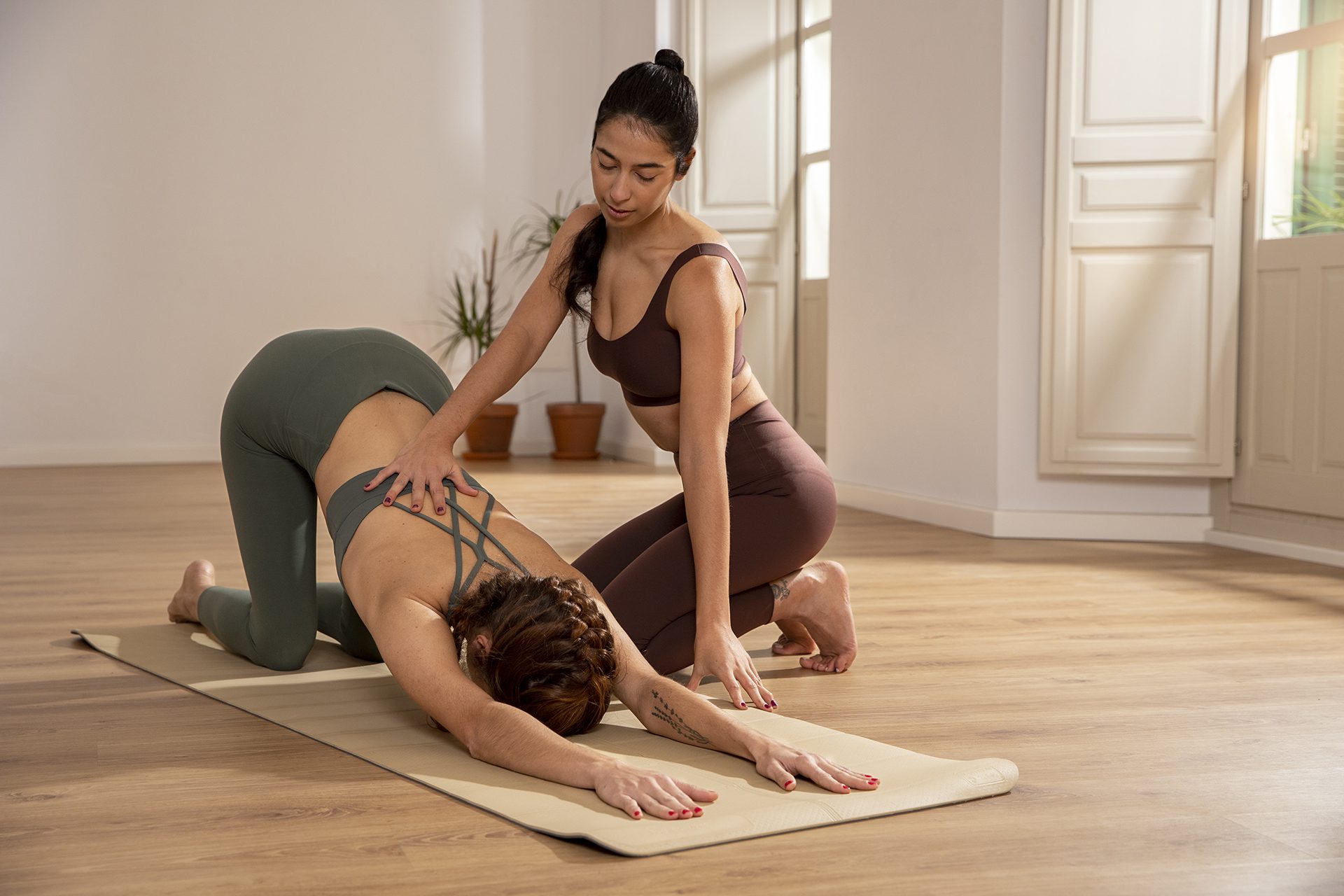Sequencing Yoga Classes with Intention
As yoga teachers, sequencing and creating meaningful class plans are integral to providing your students with a real experience. Sequencing with intention can determine the eventual harmony between the body, breath and mind. Crafting a sequence or class plan involves designing purposeful flows that cater to the diverse needs of students, fostering growth, healing, and transformation on and off the mat. Yoga sequencing courses, such as a 50-hour advanced sequencing Vinyasa course, put immense emphasis on the need for crafting flows that are balanced, meaningful and include modifications. Such courses enrich your understanding of Vinyasa flow yoga, while providing valuable insights into this dynamic and creative style of yoga.

In this article, we will deep dive into the art of sequencing yoga classes with intention, ensuring a fulfilling and enriching practice experience.
STAYING MINDFUL OF STUDENT NEEDS
Before crafting a yoga sequence, it’s essential to understand the diverse needs of students. Some may seek physical challenges, while others may crave relaxation and stress relief. Some may be recovering from injuries, while others may be on a spiritual quest. Some may aim to enhance flexibility, strength, or balance. By recognizing these varied needs, you can tailor sequences to cater to different levels, abilities, and goals, ensuring inclusivity and accessibility for all. For instance, therapeutic sequences may focus on gentle stretches, restorative poses, and mindful breathing to promote healing and relaxation, while dynamic flows may emphasize strength-building and energizing postures to invigorate the body and mind. In some cases, you may not be able to do both in the same class (especially if it is a larger group size).
If you’re looking to specialize in a specific area or a target group, you can also choose to do additional sequencing courses that will help you. For example, you can choose from a Yin Yoga sequencing course, Hatha Yoga TTC or an Ashtanga Vinyasa sequencing course. These yoga teacher training courses will deep dive into sequencing, equipping you with the ability to craft purposeful sequences with different goals.
SETTING AN INTENTION IN YOGA SEQUENCING
Intention in yoga sequencing goes beyond merely stringing together poses. It involves thoughtful planning aimed at achieving specific outcomes for practitioners. Whether it’s cultivating strength, flexibility, balance, or inner peace, each class should have a clear intention guiding the sequence. Intention provides direction, coherence, and meaning to the practice, allowing students to connect more deeply with themselves and the present moment. When planning for your class, take the time to pen down the intention and goal. Then, at the beginning of your yoga class, you can spend a few minutes explaining this intention to your students. You can even encourage them to be mindful of the intention and to notice if they feel the impact by the end of the class.
CREATING A BALANCED FLOW
A well-rounded yoga class typically comprises various elements such as warm-up, sun salutations, standing poses, balancing poses, inversions, backbends, twists, seated poses, and relaxation. The key is to weave these elements seamlessly into a flow that addresses different aspects of the practice. For instance, starting with gentle warm-up exercises gradually transitions into more dynamic movements, leading to peak poses, before winding down with calming postures and relaxing in Savasana (the Corpse Pose). However, this is a general sequence and is not always applicable in certain styles of yoga. Depending on your specialization, you can explore sequencing in different styles with courses such as a 50-hour advanced sequencing Vinyasa course, a Yin Yoga TTC, and so on.
ADAPTING TO STUDENT LEVELS
Another aspect to keep in mind when crafting your sequence is the level of students. In a mixed-level class, sequencing involves offering modifications and variations to accommodate students of different abilities and experience levels. This ensures that everyone feels challenged yet safe in their practice. Incorporating options for both beginners and advanced practitioners empowers students to honor their bodies’ needs while encouraging growth and exploration. You also have to keep in mind the importance of alignment. Ask permission and make the necessary adjustments to a pose. If a student is unable to access a challenging posture, be ready to provide a simpler modification. This also motivates them to continue coming to class as they feel like their needs are always factored in by you.
MINDFULNESS AND SELF-AWARENESS
Intentional sequencing encourages mindfulness and presence throughout the practice. By incorporating breath awareness, meditation, and mindful movement, students are guided to cultivate a deeper connection with their breath, body, and inner being. Each transition becomes an opportunity to anchor oneself in the present moment, fostering a sense of peace, clarity, and self-awareness. Moreover, during the class, encouraging students to keep their mind focused on the present moment will gradually foster mindfulness in them on and off the mat.
ALIGNING WITH THEMES AND INTENTIONS
Over time, you can bring in uniqueness to your classes by adding themes. Themes add depth and meaning to yoga classes, providing a focal point for exploration and reflection. Whether it’s gratitude, self-love, courage, or acceptance, integrating thematic elements into sequencing amplifies the practice’s transformative potential. Poses, breath work, and guided meditations can be aligned with the chosen theme, reinforcing the intention and guiding students towards deeper insights and self-discovery. For example, if your theme is self-love, your class can focus on backbends and chest-openers and a Heart Center (Anahata Chakra) meditation.
SUPPORTING EMOTIONAL WELL-BEING
Yoga has the power to uplift spirits, soothe troubled minds, and promote emotional well-being. Sequencing can be instrumental in creating a supportive environment for emotional exploration and healing. If your classes boast of providing a well-rounded, holistic experience, then you may need to ensure you incorporate heart-opening poses, grounding postures, and soothing breath work that can help students release tension, cultivate self-compassion, and promote emotional balance and resilience both on and off the mat.
EMPOWERING SELF-EXPRESSION AND CREATIVITY
While adherence to alignment principles is crucial for safety and efficacy, sequencing also enables you as a yoga teacher to draw emphasis on self-expression and creativity, and empower students to experience this. Providing opportunities for students to explore variations, transitions, and intuitive movements creates a sense of ownership and empowerment in their practice. Moreover, encouraging self-exploration and experimentation allows students to tap into their innate wisdom and discover new possibilities within themselves.
Sequencing yoga classes with intention is an art form that requires creativity, compassion, and mindfulness. By understanding the diverse needs of students, crafting balanced flows, aligning with themes and intentions, you can create purposeful sequences that cater to individual growth, healing, and transformation. Ultimately, it’s not just about the poses; it’s about the journey inward, guiding students towards greater self-awareness, wholeness, and connection with the essence of yoga.
Master this craft with a yoga sequencing certification course to learn all the ins and outs of creating mindful flows and how to teach them with the right impact.
YOGA ALLIANCE REGISTERED YOGA TEACHER TRAINING COURSES

Sampoorna Yoga Teacher Training School has been a registered international yoga school with Yoga Alliance, holding RYS-200, RYS-300, RYS-500, and YACEP designations since 2009. Its online and in-person Yoga Teacher Training Courses and Certifications are recognized and accepted worldwide, enabling all graduates to teach globally. Upon course completion, participants receive a 200-Hour, 300-Hour, or 50-Hour Yoga Teacher Training Certification, allowing registration as RYTs (Registered Yoga Teachers) with Yoga Alliance. Our Yoga Teacher Training Certificate Courses empower you to teach legally in any country, whether you choose to register with Yoga Alliance registration or not.

